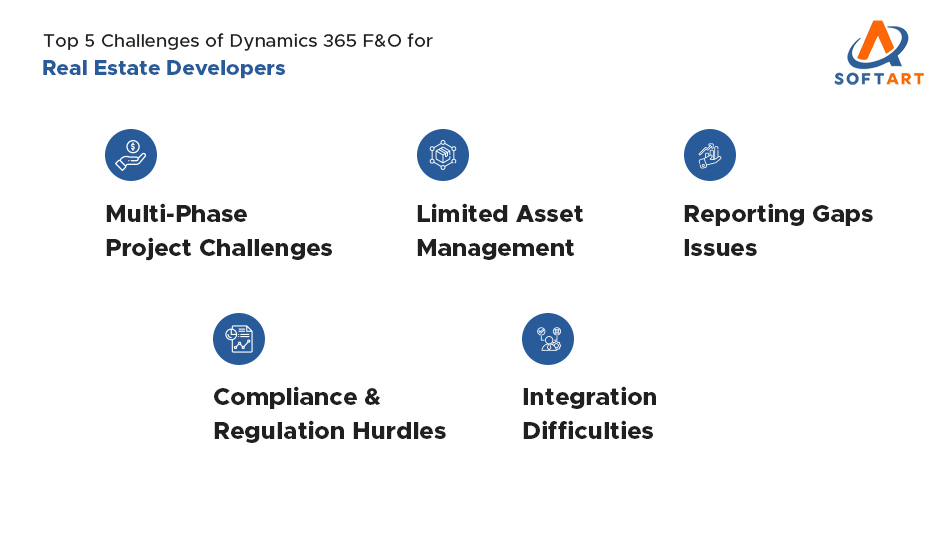Does Dynamics 365 Finance and Operations support real estate? For many real estate developers this is a critical question. Dynamics 365 F&O is a powerful ERP system that helps businesses manage finance, operations and supply chains. But when it comes to real estate then it often falls short in ways that can impact project timelines, budgets and overall efficiency.
If you’re a developer managing multiple properties investors and construction projects, understanding these limits is essential before investing time and money into implementation. In this blog, we’ll explore the key limitations of Dynamics 365 F&O for real estate developers, why they matter and practical ways to overcome them.
Key Limitations of Dynamics 365 F&O for Real Estate Developers
Real estate development comes with unique challenges that standard ERP systems including Dynamics 365 F&O are not fully equipped to handle. Here are the major limitations:
1. Multi-Phase Project Accounting Is Complex
- Real estate projects often run in phases: land acquisition, construction, sales and handover.
- Standard Dynamics 365 F&O is built for general finance and operations not phased project accounting.
- Problem: Allocating costs, tracking subcontractor payments and recognizing revenue for each phase is difficult without heavy customization.
- Impact: Mismanaged budgets and delayed financial reporting.
2. Lack of Real Estate Asset Management
- F&O doesn’t natively track property portfolios, leases or tenant details.
- Developers need to monitor asset valuation, maintenance and occupancy across multiple projects.
- Problem: Without additional modules or integrations, tracking properties becomes manual and error-prone.
- Impact: Missed deadlines, inaccurate reporting and frustrated investors.
3. Limited Reporting for Real Estate KPIs
- Real estate projects demand real-time insights: project profitability, cash flow forecasts and milestone completion.
- Dynamics 365 dashboards are generalized and need extensive customization for real estate-specific KPIs.
- Problem: Generating meaningful reports often requires extra tools or manual effort.
- Impact: Decision-making slows down and risks increase.
4. Regulatory Compliance Challenges
- Real estate developers face complex local and national regulations including tax laws, building codes and reporting standards.
- Dynamics 365 F&O doesn’t include ready-made tools for real estate compliance, requiring add-ons or manual processes.
- Impact: Higher risk of audit penalties and compliance errors.
5. Integration Gaps
- Many real estate firms use specialized project management, construction and tenant management tools.
- Dynamics 365 F&O often struggles to integrate seamlessly with these platforms.
- Problem: Without proper integration, data silos form, reporting is inconsistent and errors increase.
- Impact: Lost time, duplicated effort and poor decision-making.
Why These D365 Limits Matter Now?
Not taking these limitations into consideration might lead to very costly situations:
- Delays in project timelines: the slow tracking of costs and progress has a negative effect on handovers.
- Budget overruns: the improper allocation of costs can lead to an increase of expenses without the knowledge of the budget.
- Investor dissatisfaction: the delayed and inaccurate reporting that is made to investors can considerably reduce their confidence in the project.
- Team inefficiency: the manual workarounds that are used consume resources and lower the team’s productivity.
Knowing these gaps ahead of time before implementation gives you the opportunity to plan the right strategy and thus, avoid costly surprises.
How Real Estate Developers Can Address Dynamics 365 F&O Limitations?
While Dynamics 365 F&O has its limits you can overcome them with integration, customization and process improvements.
1. Use Project Management Extensions
- Problem: F&O doesn’t handle multi-phase project accounting natively.
- Solution: Integrate construction/project management tools or use custom templates.
- Benefit: Track costs per project phase, manage subcontractor payments and recognize revenue accurately.
2. Advanced Asset Tracking
- Problem: F&O lacks real estate asset management.
- Solution: Connect property management systems or create custom modules.
- Benefit: Automate tracking of properties, maintenance schedules, lease agreements and valuations.
3. Enhanced Reporting
- Problem: Standard dashboards don’t cover real estate KPIs.
- Solution: Integrate Power BI or other analytics tools.
- Benefit: Generate real-time reports on project profitability, cash flow and milestone completion.
4. Automate Regulatory Compliance
- Problem: Compliance for taxes and local laws is manual.
- Solution: Use compliance add-ons or automated workflows within F&O.
- Benefit: Reduce errors, save time and avoid penalties.
5. Dynamics 365 Finance and Operations Integration Service
- Problem: Connecting F&O with external tools can be difficult.
- Solution: Use Dynamics 365 Finance and operations integration service for seamless data flow.
- Benefit: Avoid duplicate data, reduce errors and improve decision-making.
Step-by-Step D365 Framework for Real Estate Developers
Here’s a simple roadmap to optimize Dynamics 365 Finance and operations integration services for real estate:
Step 1: Evaluate Current Processes
- Review your existing ERP, legacy tools and manual workflows.
- Identify gaps like project accounting, asset management or reporting delays.
Step 2: Map Real Estate Workflows
- Document workflows for construction phases, tenant management and payments.
- Highlight areas where F&O can support and where integrations are needed.
Step 3: Implement Integrations
- Connect F&O with project management, property and compliance tools.
- Automate data flows to reduce errors and save time.
Step 4: Customize Reports and Dashboards
- Use dashboards to track profitability, cash flow and milestones.
- Make reports simple and real-time for management and investors.
Step 5: Train Your Teams
- Conduct training for finance, operations and project teams.
- Update workflows based on real-time insights from dashboards.
Practical Tips to Avoid Common Pitfalls
- Avoid over-customization: Too many modifications make upgrades difficult.
- Prioritize integrations: Focus on critical tools for construction, finance and asset management.
- Track KPIs early: Identify key metrics before implementation.
- Change management: Prepare teams for workflow changes to avoid adoption issues.
- Pilot test: Run a pilot project before full-scale deployment to uncover hidden issues.
Dynamics 365 F&O Cost, Time and ROI
| Aspect | Typical Range | Notes |
|---|---|---|
| Implementation Time | 6–12 months | Depends on project size and integrations |
| Integration Costs | $50k–$200k | Varies by tools and custom modules |
| ROI | 12–24 months | Faster reporting, improved accuracy, better project tracking |
Planning for these factors helps ensure your investment in Dynamics 365 F&O adds real value, rather than creating frustration.
Real-World Example
A mid-size real estate developer struggled with multi-project tracking and reporting. Using Dynamics 365 F&O alone costs were misallocated and project reports delayed. After integrating construction management and tenant tracking tools, the firm:
- Reduced project reporting time by 30%
- Cut administrative work by 20%
- Achieved real-time project visibility for stakeholders
This shows that Dynamics 365 F&O can work effectively with real estate but only when limitations are understood and addressed.
Navigating Dynamics 365 F&O Limitations for Real Estate Success
Knowing the limitations and does dynamics 365 finance and operations support real estate is the very first step to making it work for real estate development. Although the system is great in general finance and operations, its deficiencies in project accounting, asset management, reporting, compliance, and integrations can negatively impact the execution of the entity in the real world if these issues are not taken care of.
Developers can get over these hurdles by having a correct plan of their work processes, being aware of the system’s limitations at a very early stage, using integrations to link specialized real estate tools, customizing dashboards for actionable insights and implementing a phased approach with pilot projects. With the proper strategy and assistance, real estate teams will be able to elevate their productivity, lessen the likelihood of making mistakes and obtain a real-time overview which is a turning point in the challenges of Dynamics 365 F&O into opportunities for smarter project management.
Frequently Asked Questions:
1. What are the main limitations of Dynamics 365 F&O for real estate projects?
Ans. Firstly and mainly, among the limitations are the issues with multi-phase project accounting, lack of real estate asset management, weak KPI reporting, and difficulties in regulatory compliance and integration with specialized real estate tools.
2. Does Dynamics 365 Finance and Operations fully support real estate developers?
Ans. Not entirely. In only a few areas, Dynamics 365 F&O is a great solution for financial and operational management, but it does not inherently offer real estate-specific features such as multi-phase project accounting, lease tracking, tenant management, and property portfolio management.
- How can real estate developers fill the gaps in Dynamics 365 F&O?
Ans. Developers may plan the shortcomings by using integration services, customizing dashboards and workflows, linking specialized property management and project tools, and setting up a phased approach with pilot testing.
- Can Dynamics 365 F&O integration services improve real estate operations?
Ans. Yes, real estate developers who are eager to implement integration services for Dynamics 365 Finance and Operations can effortlessly link F&O with project management, tenant tracking, and financial forecasting tools and thus make data available in real-time, have better reporting, and fewer errors.








